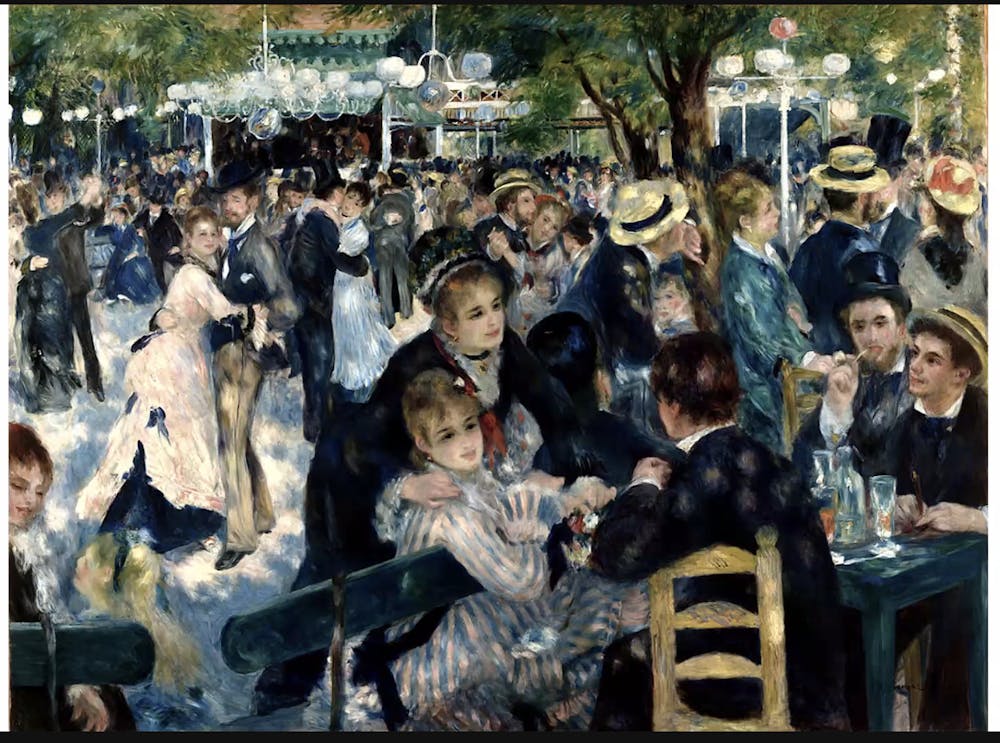On Feb. 25 I celebrated one of my favorite artist’s birthdays at the “Pierre-Auguste Renoir 180th Birthday — Livestream Art Program” hosted by Robert Kelleman, founder and director of non-profit organization Washington, D.C. History & Culture. As a participant of the virtual art gallery tour, I was fondly reminded of my previous tourist experiences in art galleries.
Although many people know Renoir’s artistic masterpieces, few know the history behind his artwork. During the livestream art program, I was astounded by Renoir’s colorful background and the interactions he sustained with people during his lifetime. One of his friends was Claude Monet, another famous artist who was, and still is, globally admired.
I found Renoir’s friendship with Monet striking because they both managed to pursue the same goal and became successful artists. Two pieces that were each drawn from the same vantage point, one by Renoir and the other by Monet, were presented during the program. The decision to present the two artists’ drawings was confusing to me at first; I had thought that the program was deviating from the focus on Renoir, but Kelleman’s explanation of the contrast between the two pieces served to better highlight the characteristics of Renoir’s art.
A special feature of Renoir’s drawings was his focus on both people and light, while Monet focused more on light and less on the people. For instance, Monet would exclude a crowd in order to focus more on scenic coloring and shading, while Renoir would include a detailed depiction of said crowd. I was also pleased by Renoir and Monet’s choice to create artwork from the same vantage point because I’m able to relate to the friendship that sparked between the two artists.
Sophomore Jay Jung, who attended the livestream, noted a similar theme within Renoir’s artwork.
“I’ve seen artwork by Renoir before, and I could see there was a common theme among the artwork,“ he said. “However, I never knew his name until I watched the livestream program.”
Like Jung, many people observe a dreamy aspect of Renoir’s artwork. As Kelleman periodically pointed out, Renoir’s quick brush strokes in some of his work give the cloudy yet ironically distinct shape to the people portrayed in his art. Another matter worth noting is that Renoir painted more women than men; as the son of a dressmaker and a tailor, Renoir was naturally exposed to the fashion world and reflected his attention to detail for women’s dresses directly into his own art.
The painter was quite well known for his portraits during his time. According to Kelleman, Renoir actually had a tendency to destroy his artwork if he was dissatisfied. This image gave me a drastically different impression about him, as I had thought that his airy drawings were a reflection of his character.
Over time, Renoir slowly transitioned from painting portraits to painting scenery. One of my favorite drawings by Renoir is the Dance at Le moulin de la Galette. I was elated at the elaboration on this painting during the livestream.
The painting shows a crowd of people, and what’s exceptional about it is the multiple angles of people captured in one scene. It may not sound like much, but Kelleman noted that the variety of angles gives the effect that we are part of the painting. For me, I could almost hear the chatter of the people, which is something we are all much less exposed to given the current COVID-19 situation.
Sophomore Hyunwoo Roh also attended the livestream. He paid special attention to the range of expressions shown in Renoir’s paintings.
“I like the jovial feeling that Renoir’s paintings give off,” he said. “When I look at the facial expressions of [the people in the image], I can tell that they are enjoying the social atmosphere.”
According to Kelleman, Renoir created his artworks to reflect these very emotions. During the program, it was mentioned that Renoir’s goal was to convey happiness to people because in his opinion, there exists adequate sadness in the world. I appreciate this motive behind Renoir’s art because it serves as a reminder that we should appreciate and take joy in the present more, and this is especially important during our ongoing pandemic.
Compared to an in-person art gallery tour, I thought the virtual version allowed me to focus better on the painting. From my past experiences, visiting a popular art exhibition like Renoir’s was a mix of fighting through the crowd for a good viewing of the art and barely hearing the tour guide’s voice.
I was happy to avoid all of that through a virtual livestream. However, I do miss the characteristic scent of old paintings in art galleries and the opportunity to see the unique texture of the paintings in real life. Hearing the opinions of others in the tourism group before the pandemic was what I especially valued because it offered more perspective on a painting.
For those who miss viewing paintings and want to see famous artworks, a virtual livestream like the one provided by Washington, D.C. History & Culture would be a COVID-19-safe option. I had a great experience learning these personal details about the artist — it made me look at Renoir’s paintings with a fresh pair of eyes.





